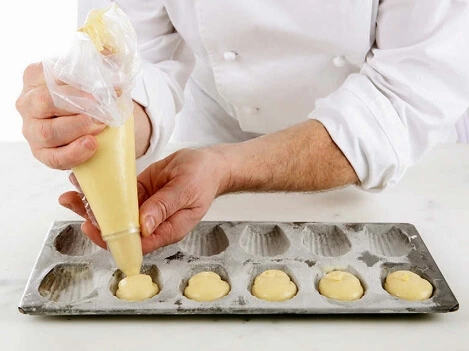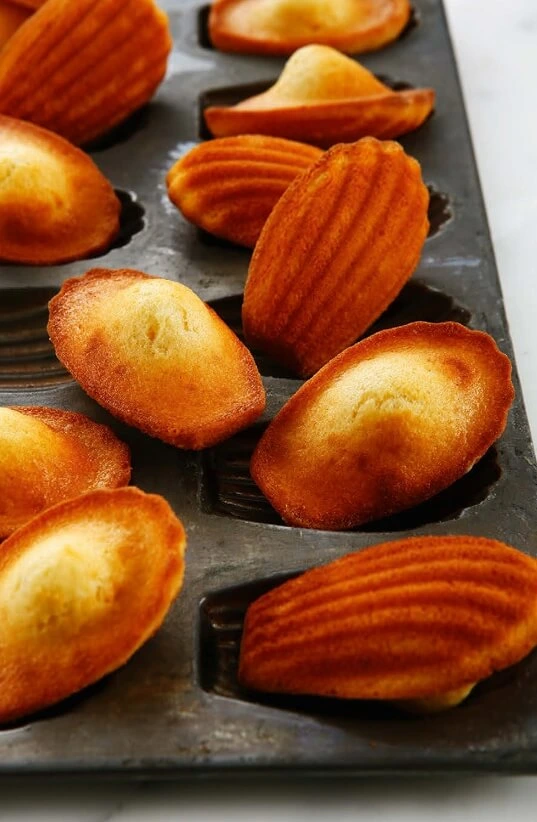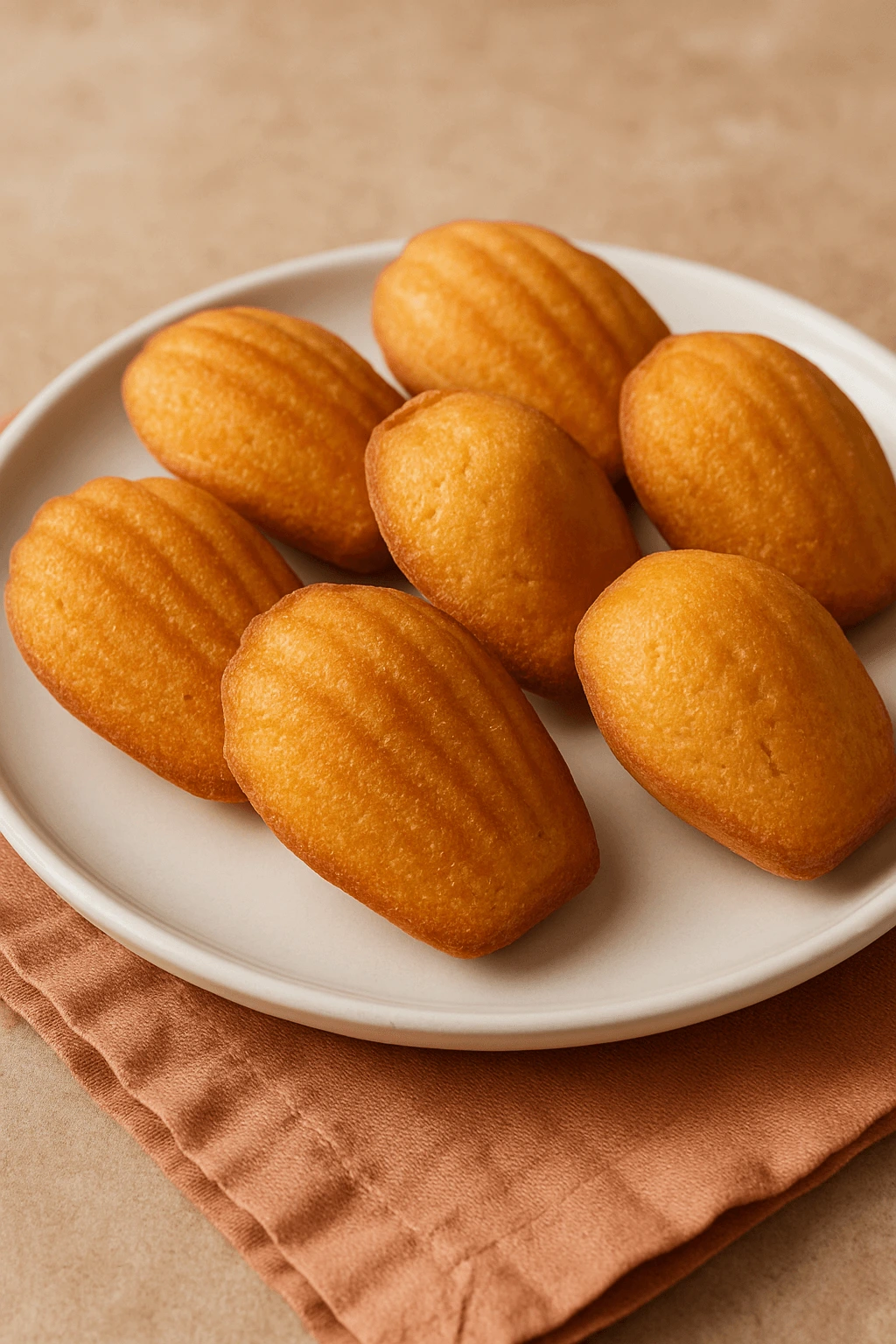Few pastries capture the charm of French baking quite like the Madeleine. With its distinctive scalloped shell shape and lightly golden hue, this small cake is a masterpiece of texture and tradition. Though simple at first glance, the Madeleine embodies a rich cultural history and delicate craftsmanship that have made it a beloved symbol of refinement across generations.
More than a treat, the Madeleine is a memory. Immortalized by Marcel Proust in In Search of Lost Time, the Madeleine has become an icon of nostalgia and sensory pleasure. One bite dipped into a cup of tea, and suddenly, the world slows down. It’s not just about taste—it’s about experience. The soft crumb, the gently crisp edges, and the subtle perfume of citrus or vanilla transport the eater to the quiet warmth of a French salon or a grandmother’s kitchen.
Traditionally baked in fluted molds to give them their signature shape, Madeleines are known for their lightness and distinctive little “hump”—a sign of a well-executed recipe and precise temperature control. Though they require only a few simple steps, their perfection lies in the details: the gentle mixing of the batter, the rest time that allows flavors to deepen, and the oven’s heat that gives them their beautiful rise.
Despite their heritage, Madeleines are endlessly adaptable. Classic versions may feature lemon zest or vanilla, but modern pâtissiers play with flavors like matcha, honey, orange blossom, or chocolate. Some coat them with a thin glaze, others dip them in ganache, but all preserve the tender core that makes this cake so special.
What’s most enchanting about Madeleines is their ability to elevate the everyday. Served with tea, espresso, or as part of a refined dessert table, they offer both comfort and elegance. They are at once timeless and current—sophisticated yet humble.
Whether you’re baking for guests, for yourself, or for the pure joy of it, Madeleines remind us that beauty often lies in the small things. They don’t shout—they whisper, and in doing so, they linger in memory far longer than their few delicate bites would suggest.
Madeleine Baking Sheet (for 12 cakes)
Preparation Time
15 minutes
Chilling Time
1 hour 30 minutes (mandatory for the signature hump)
Baking Time
10 to 12 minutes, depending on your oven
Storage
- Up to 1 week in a dry, airtight container
- Up to 3 months in the freezer, well-wrapped
Required Equipment
- Whisk
- Thermometer (for butter or batter temperature control)
- Fine-mesh sieve
- Microplane zester (ideal for citrus zest)
- Piping bag with a plain 10 mm tip
- Madeleine mold (non-stick or buttered metal preferred)
Ingredients
- 100 g eggs
- 115 g sugar
- 15 g honey
- 80 g warm milk
- 180 g all-purpose flour
- 6 g baking powder
- 250 g melted butter
- A sufficient amount of vanilla (extract or paste)
- Zest of 1/3 lemon, finely grated
Method
- In a mixing bowl, whisk together the eggs, sugar, and honey until well combined.
- Add the warm milk (approximately 20 °C) and mix gently.
- Sift the flour with the baking powder, then add it to the mixture. Stir until smooth.
- Pour in the melted butter and add the vanilla. Mix until fully incorporated.
- Finely grate the lemon zest into the batter and stir. Cover the bowl and refrigerate the batter for 1 hour 30 minutes to allow it to rest and develop flavor.
- Preheat the oven to 190 °C (375 °F / Gas mark 5–6). Meanwhile, butter and flour the madeleine molds thoroughly.
- Using a piping bag fitted with a plain 10 mm tip, fill each mold two-thirds full.

- Bake for 10 to 12 minutes, or until the madeleines are golden and puffed with their characteristic hump.
- Once baked, remove from the oven and immediately wrap the madeleines in plastic wrap while still warm. This step helps keep them moist and tender.

Chef’s Tips & Tricks
- Let the batter rest for 1 hour 30 minutes in the refrigerator. This resting time is essential for flavor development and helps create the classic domed top.
- Grease the molds with softened butter (not melted), then dust them with flour or a light coating of cornstarch. This ensures a clean release and a delicate outer crust.
- For a more pronounced hump, you can briefly freeze the filled molds before baking. A chilled batter hitting a hot oven promotes that perfect rise.
Conclusion: The Magic in Every Madeleine
Baking Madeleines is not just about following a recipe — it’s about capturing a moment, a texture, and a tradition. These shell-shaped little cakes may appear modest, but they carry with them the soul of French pâtisserie: delicate technique, refined simplicity, and pure pleasure.
Whether enjoyed warm from the oven with a cup of tea, or wrapped and saved for a sweet pause during the week, Madeleines have a way of turning the ordinary into something quietly extraordinary. Their gentle citrus aroma, their tender crumb, and their signature hump are all the reward of a baker’s patience and care.
With the right tools, a touch of precision, and the chef’s secrets at your side, you’ll find that Madeleines are well within your reach. And once you’ve mastered them, you’ll return to them again and again — for breakfast, teatime, or just because nothing else will quite do.
Madeleines Q&A: Everything You Wanted to Know
Why does my Madeleine batter need to rest for 1 hour 30 minutes?
Resting the batter helps relax the gluten and allows the flour to fully absorb the liquid. More importantly, the temperature contrast between the cold batter and the hot oven promotes the characteristic hump. Don’t skip this step — it’s key to authentic Madeleines.
Can I skip the lemon zest or substitute other flavors?
Absolutely! Lemon zest adds a lovely brightness, but you can substitute orange zest, a touch of almond extract, orange blossom water, or even infuse the milk with tea for unique variations. Just keep the flavors balanced and delicate.
What type of butter is best for Madeleines?
Use high-quality unsalted butter for the best flavor. European-style butter with a higher fat content (around 82%) gives the Madeleines a richer taste and better texture.
Why didn’t my Madeleines rise or form a hump?
This could be due to:
- Batter not being cold enough
- Oven not hot enough
- Overmixing the batter
- Not enough baking powder
Be sure to chill your batter, preheat your oven properly, and handle the mixture gently.
How do I store Madeleines and keep them fresh?
Once cooled, wrap your Madeleines in plastic film to retain moisture. Store them in an airtight container in a dry place for up to one week. For longer storage, freeze them individually wrapped for up to 3 months. Let them come to room temperature before serving.
Can I make the batter in advance and bake later?
Yes! You can prepare the batter up to 24 hours ahead and keep it chilled in the refrigerator. You can also pipe the batter into the molds, freeze them, and bake directly from frozen — just add an extra minute or two to the baking time.
Are Madeleines cakes or cookies?
Technically, they’re small sponge cakes, although their size and appearance often lead people to mistake them for cookies. In France, they’re considered part of the “petits gâteaux” family — elegant little cakes meant for afternoon tea or light desserts.

